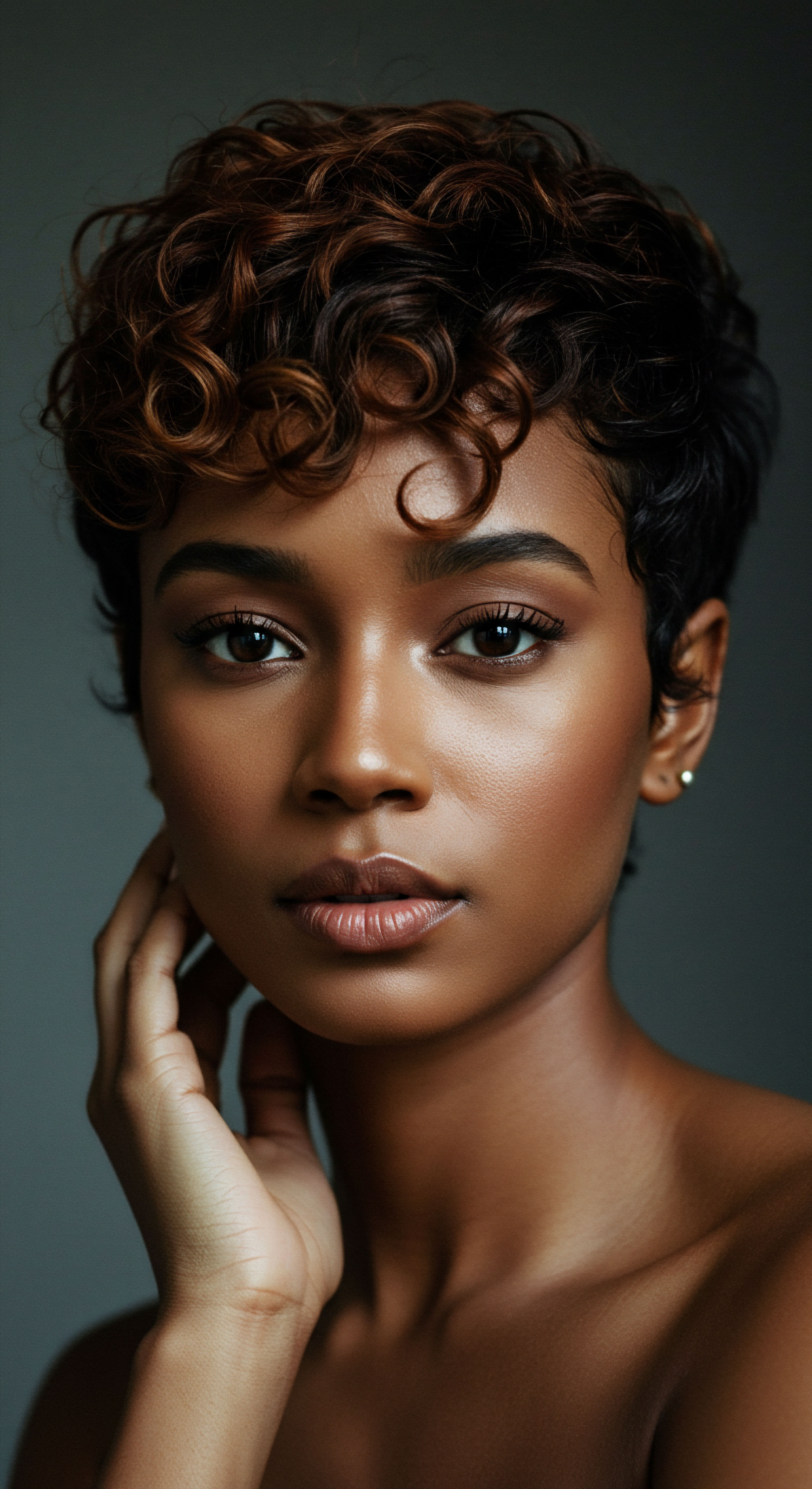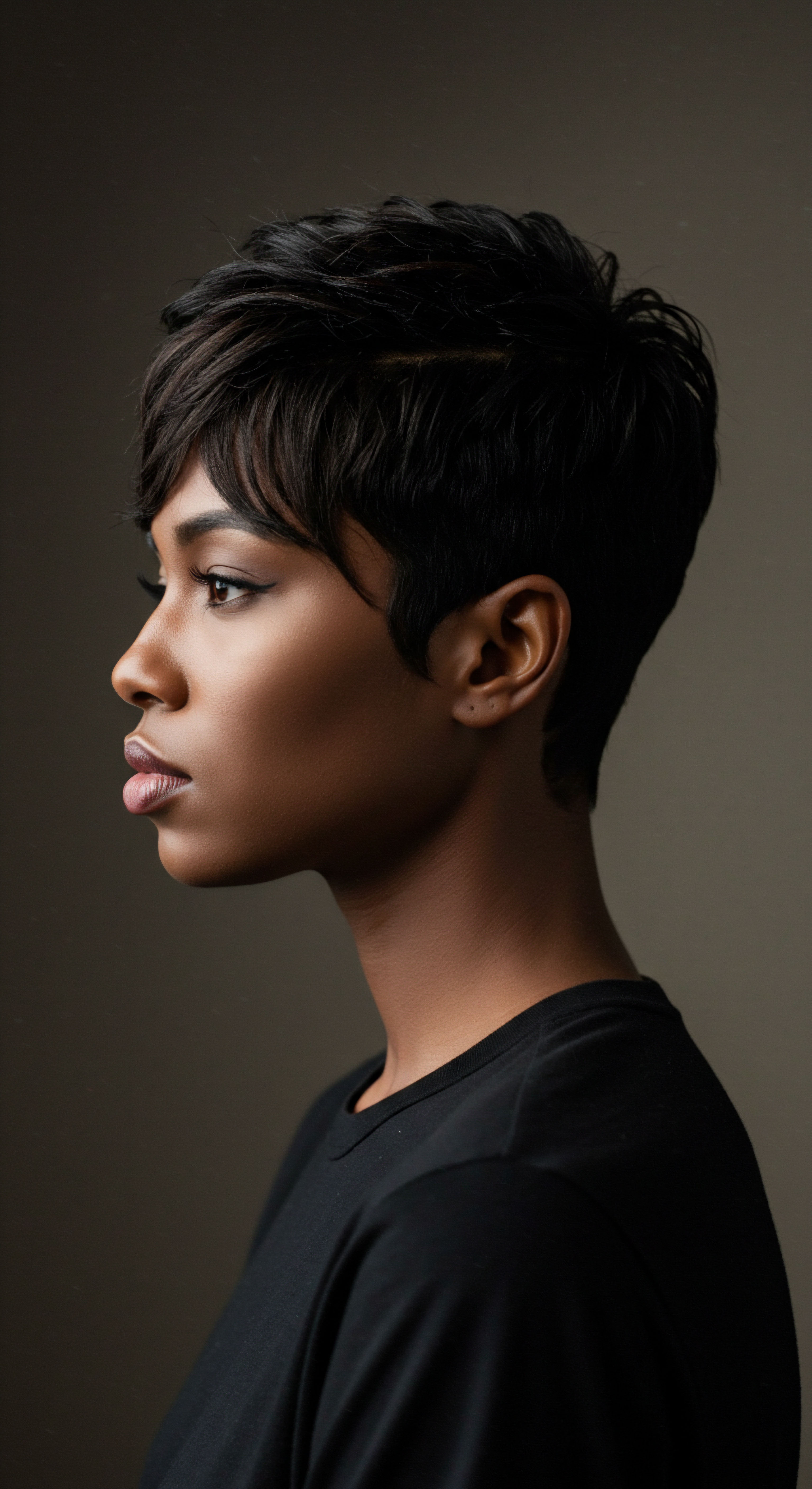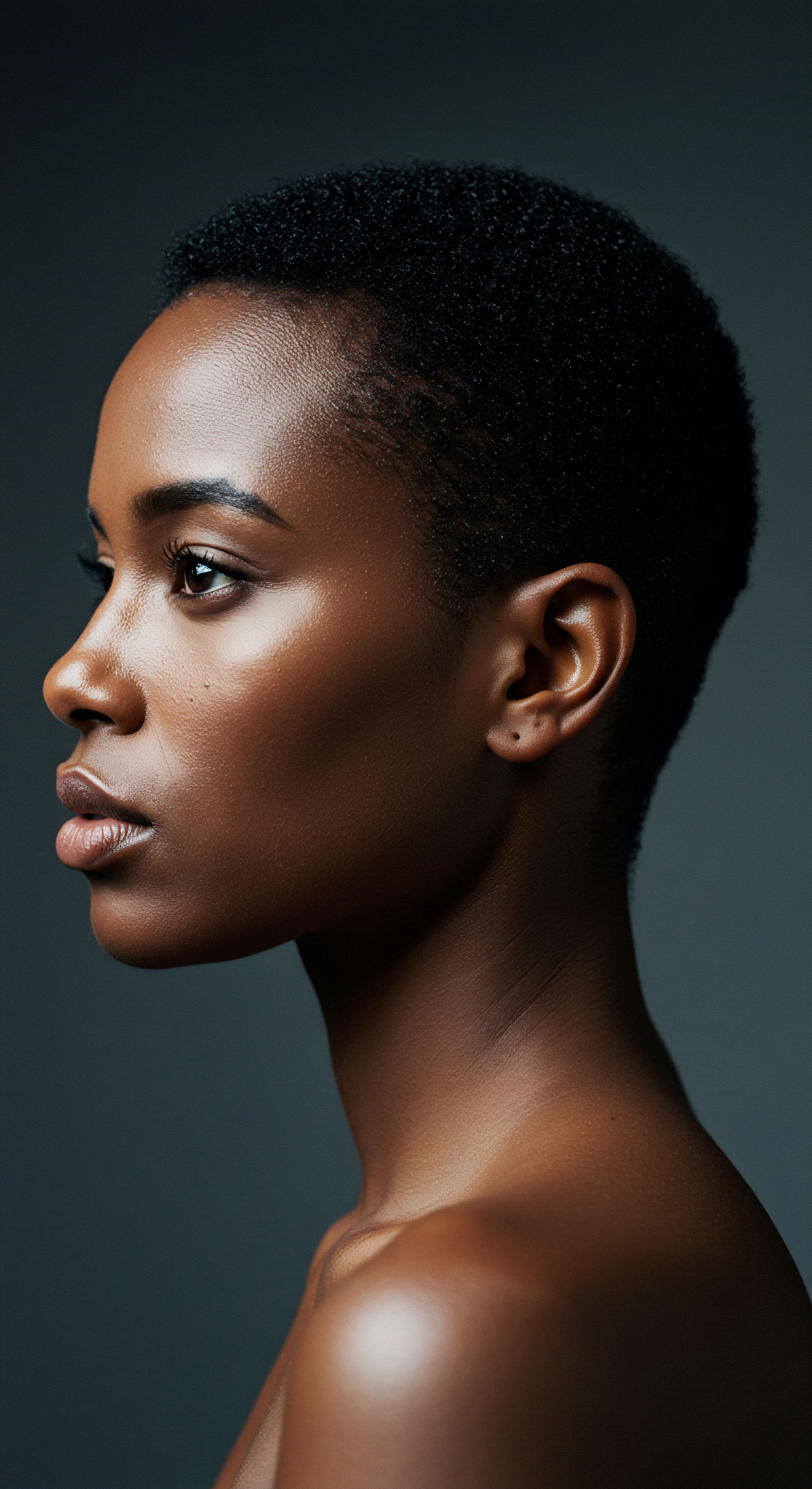
Roots
Beneath the intricate coils and waves lies a story, often whispered, of the very ground from which our strands ascend ❉ the scalp. It is here, in this fertile terrain, that the dialogue between our inner rhythms and the world outside truly begins for textured hair. This exploration seeks to trace the subtle, yet powerful, influence of scalp moisture upon the very vitality of these remarkable strands.
It is a contemplation of origins, a quiet observation of how the delicate balance of the scalp’s hydration shapes the strength, flexibility, and overall well-being of hair that defies simple categories. We stand at the threshold of understanding the foundational elements, the very architecture that supports our hair’s magnificent expression.
Our journey begins with the microscopic, the unseen world of the hair follicle. For textured hair, the follicle’s shape plays a distinct role in how sebum, the scalp’s natural oil, travels down the hair shaft. Unlike straight hair, where sebum glides easily along a smooth, cylindrical path, the elliptical or flattened shape of textured hair follicles, combined with the twists and turns of the hair itself, creates a more circuitous route.
This anatomical distinction means that the scalp’s natural moisturizing efforts face a greater challenge in reaching the full length of each strand, particularly the ends. Consequently, the inherent propensity for dryness in textured hair often traces back to this fundamental follicular architecture and the subsequent distribution of natural lipids.

What Does Hair Anatomy Tell Us About Scalp Hydration?
The scalp itself is a complex ecosystem, a living extension of our skin, complete with sebaceous glands, sweat glands, and a protective barrier. The health of this barrier is intrinsically tied to its moisture content. When the scalp is adequately hydrated, its barrier functions optimally, guarding against irritants, microbes, and excessive transepidermal water loss.
Conversely, a dehydrated scalp can compromise this barrier, leading to a cascade of concerns that directly impact hair health. A scalp lacking sufficient moisture may feel tight, itchy, or flaky, symptoms that signal distress at the root level.
The very architecture of textured hair follicles shapes how natural moisture reaches each strand.
Understanding the essential lexicon of textured hair extends beyond curl patterns to include the language of scalp health. Terms like Sebum Regulation, Scalp Microbiome Balance, and Transepidermal Water Loss become central to grasping the science behind effective care. Sebum, a blend of triglycerides, waxes, squalene, and cholesterol, is vital for conditioning both the scalp and hair.
Its production is influenced by genetics, hormones, and even environmental factors. When sebum production is either too low or too high, the scalp’s moisture equilibrium can be disrupted, leading to issues that compromise the hair’s foundation.
The hair growth cycle, a continuous process of growth, regression, and rest, is also susceptible to the influence of scalp moisture. A healthy, well-hydrated scalp provides the optimal environment for follicles to produce strong, vibrant strands during the anagen (growth) phase. Chronic scalp dryness or irritation, however, can stress the follicles, potentially leading to premature shedding or a compromised growth cycle. This can manifest as slower growth, thinner strands, or increased breakage, underscoring the deep connection between the scalp’s condition and the hair’s ability to flourish through its natural cycle.

How Do Hair Growth Cycles Relate to Scalp Health?
Consider the anagen phase, the active growth period for hair. During this time, follicular cells are rapidly dividing and building the hair shaft. This metabolic activity requires a robust supply of nutrients and a stable environment.
A parched, inflamed scalp can impede this process, potentially shortening the anagen phase or leading to the production of weaker, more brittle hair. Conversely, a scalp that maintains its delicate moisture balance fosters an environment conducive to sustained, healthy growth, allowing textured strands to reach their fullest potential.
- Follicle Shape ❉ The unique, often elliptical, shape of textured hair follicles means sebum struggles to travel down the hair shaft.
- Sebum Distribution ❉ Natural oils from the scalp are less effectively distributed along coily and curly strands.
- Barrier Integrity ❉ A hydrated scalp maintains a robust protective barrier against irritants and moisture loss.

Ritual
Stepping from the foundational understanding of the scalp into the realm of daily practice, we acknowledge the quiet wisdom that guides our hands. This “Ritual” section acknowledges a shared desire for practical knowledge, for the gentle guidance that transforms understanding into tangible care. It is a reflection on the daily or periodic practices that shape our experience of scalp and hair well-being, inviting us into a space where techniques and methods are explored with a nurturing touch. Here, we delve into the rhythms of care, recognizing that true hair health is not merely about addressing symptoms, but about cultivating a consistent, intentional approach to moisture from the roots upward.
Building personalized textured hair regimens centers on the nuanced needs of each individual’s scalp and strands. This involves discerning your hair’s porosity, its density, and its response to various humectants, emollients, and occlusives. For many with textured hair, the emphasis on moisture often begins with the cleansing process. Shampoos that strip the scalp of its natural oils can exacerbate dryness, creating a cycle of dehydration.
Opting for gentle, sulfate-free cleansers that cleanse without depleting the scalp’s inherent moisture is a cornerstone of a supportive regimen. Following cleansing, conditioning becomes a deliberate act of replenishment, infusing both hair and scalp with hydrating agents.

What are the Pillars of a Moisture-Centric Hair Regimen?
A moisture-centric regimen for textured hair often follows a logical progression, ensuring each step contributes to sustained hydration.
- Gentle Cleansing ❉ Select shampoos designed to preserve scalp moisture, often featuring hydrating ingredients.
- Deep Conditioning ❉ Regular use of deep conditioners helps to replenish moisture and strengthen the hair’s internal structure.
- Leave-In Hydration ❉ Applying a leave-in conditioner after washing seals in moisture and provides ongoing hydration.
- Sealing Oils/Butters ❉ Employing natural oils or butters helps to lock in the moisture from water-based products.
- Scalp Treatments ❉ Incorporating scalp oils or serums can directly address dryness and maintain barrier health.
The nighttime sanctuary, often overlooked, plays a silent, yet significant, role in maintaining scalp moisture. The simple act of protecting your hair while you sleep can dramatically impact its hydration levels. Cotton pillowcases, with their absorbent fibers, can draw moisture from both your hair and scalp throughout the night, leaving them parched by morning. This phenomenon, often underestimated, contributes to the chronic dryness experienced by many with textured hair.
Protecting hair during sleep significantly preserves vital scalp moisture.

How Do Nighttime Rituals Safeguard Scalp Hydration?
Enter the wisdom of the bonnet, the satin scarf, or the silk pillowcase. These accessories create a smoother, less absorbent surface for your hair to rest upon, minimizing friction and, critically, preserving the moisture you’ve carefully applied. This simple ritual acts as a protective shield, allowing the natural oils of your scalp and the hydrating products in your hair to remain undisturbed, fostering an environment where moisture can truly settle and sustain itself. It is a quiet testament to the power of consistent, mindful care.
Ingredient deep dives for textured hair needs reveal a fascinating array of compounds that interact with scalp moisture. Humectants, such as glycerin, hyaluronic acid, and panthenol, draw moisture from the air and bind it to the scalp and hair. Emollients, like various plant oils (jojoba, argan, coconut), help to smooth the hair cuticle and provide a soft, pliable feel, while also contributing to the scalp’s lipid barrier.
Occlusives, such as shea butter or castor oil, form a protective layer on the surface, preventing water from escaping, thereby sealing in hydration for both scalp and strands. The intelligent layering of these ingredients creates a supportive environment for sustained moisture.
When addressing textured hair problems, a compendium of solutions often begins with diagnosing the root cause of moisture imbalance. Dry scalp, flaking, and itchiness are frequently intertwined with insufficient hydration. A thorough assessment involves considering not only product choices but also washing frequency, water temperature, and even environmental humidity. For persistent flaking, it is important to distinguish between simple dryness and conditions such as seborrheic dermatitis, which requires a different approach to care, often involving medicated shampoos that still respect the scalp’s moisture barrier.
| Ingredient Category Humectants |
| Examples Glycerin, Hyaluronic Acid, Panthenol |
| Role in Scalp Moisture Attract and hold water to the scalp and hair. |
| Ingredient Category Emollients |
| Examples Jojoba Oil, Argan Oil, Shea Butter |
| Role in Scalp Moisture Soften and smooth the scalp and hair, replenish lipids. |
| Ingredient Category Occlusives |
| Examples Castor Oil, Lanolin, Petroleum Jelly |
| Role in Scalp Moisture Form a protective barrier to prevent water loss from the scalp. |
| Ingredient Category Layering these ingredients supports sustained hydration for scalp and textured hair. |

Relay
Our exploration now deepens, moving beyond the visible and the tactile into the intricate currents that shape our hair’s existence. This “Relay” section signals a transition into a more sophisticated and multi-dimensional contemplation of how scalp moisture influences textured hair health. We consider the less apparent complexities, inviting a profound insight where science, culture, and intricate details converge.
This is a space where the biological dialogue between our scalp and our environment, alongside the echoes of ancestral practices, reveals a fuller picture of hair vitality. It is a journey into the interconnectedness that defines true well-being for textured strands.
Holistic influences on hair health paint a vivid picture of how seemingly disparate aspects of our lives converge at the scalp. Our diet, for instance, provides the very building blocks for healthy hair growth. Deficiencies in essential fatty acids, B vitamins, or zinc can manifest as scalp dryness or irritation, directly compromising the scalp’s ability to maintain its moisture balance.
Similarly, chronic stress can trigger hormonal shifts that impact sebum production, leading to either an overly oily or excessively dry scalp. The external environment also plays a role, with low humidity climates drawing moisture from the scalp and hair, while pollutants can create oxidative stress that weakens the scalp barrier.

What Role Does the Scalp Microbiome Play in Hair Health?
The scalp microbiome, a bustling community of microorganisms residing on our skin, represents a frontier of understanding in hair health. A balanced microbiome contributes to a healthy scalp environment, supporting its barrier function and helping to regulate sebum. Disruptions to this delicate equilibrium, often caused by harsh products, environmental stressors, or internal imbalances, can lead to conditions like dandruff or seborrheic dermatitis, both of which severely compromise scalp moisture and, consequently, hair health. Research is beginning to show distinct microbial profiles associated with different scalp conditions and even hair types.
For instance, a study published in the Journal of Clinical and Aesthetic Dermatology noted differences in bacterial and fungal communities on healthy versus unhealthy scalps, highlighting the microbiome’s potential as a target for therapeutic interventions in scalp disorders. This suggests that future approaches to scalp moisture might involve nurturing specific microbial populations to promote overall scalp vitality.
A balanced scalp microbiome is a silent guardian of scalp moisture.
Cultural significance of scalp care stretches back through generations, reflecting ancestral wisdom and a deep reverence for hair as a symbol of identity and heritage. Many traditional practices, often passed down orally, inherently prioritized scalp health as the foundation for vibrant hair. The use of natural oils, herbal infusions, and gentle massage techniques in various African and diasporic traditions served not only to condition the hair but also to stimulate circulation and maintain the scalp’s delicate moisture balance.
These practices, honed over centuries, underscore an intuitive understanding of the scalp’s critical role, long before modern science articulated the mechanisms. The deliberate act of oiling the scalp, for example, is not merely about adding shine; it is a profound act of sealing in hydration and providing a protective layer against environmental aggressors.

How Do Environmental Factors Impact Scalp Moisture?
Environmental factors wield considerable power over scalp moisture. Humidity, or its absence, dictates how much moisture the air can either lend to or pull from your scalp and hair. In arid climates, the air acts as a sponge, readily absorbing water, leaving scalp and hair parched. Conversely, high humidity can sometimes lead to an overly moist scalp for some, or for others, cause hair to swell and frizz, which can compromise the cuticle and lead to further moisture loss from within the strand.
Hard water, prevalent in many regions, contains high mineral content that can accumulate on the scalp and hair, creating a film that impedes moisture absorption and can lead to dryness and irritation. The presence of these mineral deposits can also interfere with the natural flow of sebum, further disrupting the scalp’s moisture equilibrium.
Scientific investigations continue to peel back the layers of complexity surrounding scalp moisture and textured hair. A particularly compelling finding, though not widely publicized, comes from a study examining the lipid composition of the scalp surface in individuals of African descent. Published in the International Journal of Cosmetic Science, this research revealed that the lipid profile on the scalp of individuals with highly textured hair can differ in certain aspects compared to those with straight hair, specifically concerning the proportion of certain fatty acids.
This subtle difference, while not fully understood in its implications for moisture retention, suggests a potential underlying biochemical predisposition that influences how the scalp manages hydration and how it responds to various products. It offers a glimpse into the unique physiological considerations that may necessitate tailored scalp care strategies for textured hair, moving beyond generic advice to truly personalized approaches grounded in specific biological realities.
| Factor Type Internal Factors |
| Examples Diet, Hormones, Stress, Genetics |
| Impact on Scalp Moisture Affect sebum production, nutrient supply, and overall scalp health. |
| Factor Type External Factors |
| Examples Humidity, Pollution, Hard Water |
| Impact on Scalp Moisture Influence transepidermal water loss and product effectiveness. |
| Factor Type Microbiome |
| Examples Bacterial and Fungal Communities |
| Impact on Scalp Moisture Contribute to scalp barrier function and health, influencing moisture. |
| Factor Type A harmonious interplay of these elements is essential for optimal scalp hydration. |

Reflection
Our journey through the intricate world of scalp moisture and textured hair culminates in a quiet moment of reflection. We have traced the subtle yet profound connections from the microscopic architecture of the follicle to the grand tapestry of cultural heritage and the emerging insights of scientific inquiry. It becomes clear that the health of textured hair is not merely a superficial concern, but a dialogue with our own biology, our environment, and the wisdom passed down through generations.
The scalp, often unseen, stands as the quiet guardian, its moisture balance dictating the very vitality and expression of our strands. This understanding invites a deeper, more respectful relationship with our hair, one rooted in knowledge and nurtured with intention.

References
- Xu, Z. Ran, Y. Gao, X. Yang, Y. Li, S. Wang, S. & Zhang, J. (2016). Dandruff is associated with a decrease in the bacterial diversity and an increase in the abundance of Malassezia restricta and Malassezia globosa on the scalp. Journal of Clinical and Aesthetic Dermatology, 9(12), 33-38.
- Rawlings, A. V. Davies, M. G. & Smith, W. P. (2004). Ethnic variations in the lipid composition of the stratum corneum and the effect of environmental factors. International Journal of Cosmetic Science, 26(2), 65-72.
- Bouillon, M. & Boissy, Y. (2000). Hair biology ❉ The science of hair. CRC Press.
- Draelos, Z. D. (2011). Hair cosmetics. CRC Press.
- Goren, A. & Shapiro, J. (2020). Hair Loss ❉ Medical and Surgical Management. CRC Press.
- Halal, J. (2009). Hair Structure and Chemistry Simplified. Milady.
- Gavazzoni Dias, M. F. R. (2015). Hair cosmetics ❉ An overview. International Journal of Trichology, 7(1), 2-15.
- Tobin, D. J. (2015). Hair in Toxicology ❉ An Important Forensic Tool. CRC Press.